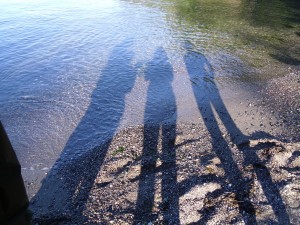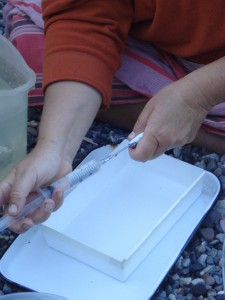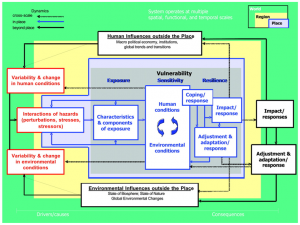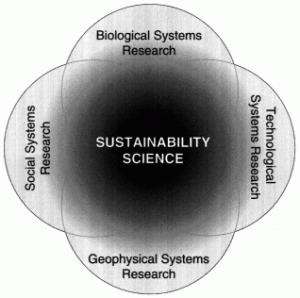What exactly is sustainability science, and why is it important? According to the United States Environmental Protection Agency (EPA), sustainability is societies ability to meet its current needs in addition to protecting the ability of subsequent generations to meet their own needs. Individuals in society seem to understand the importance of securing resources not only to satisfy their current needs, but also the future needs of their descendants. As individuals and family units, the value of sustainability is immeasurable. Parents and grandparents alike safeguard resources needed to provide adequate care to meet the demands of their offspring. As a society however, we often ignore the impact that our decisions have on those immediately around us, as well as worldwide. This encompasses not only the impact societies decisions have on the human population, but all creatures that share the earths resources with us.
Science is defined as systematic knowledge of the physical or material world gained through observation and experimentation. Throughout the last few decades it has become increasingly evident that in order for society to maintain the luxuries and lifestyles it has grown accustomed to, it must defend the environment in which it occupies. Through exploiting minerals, plants, water sources, and animals; we often destroy our most precious and valuable resources. As we continue to gain knowledge about the world around us, it is palpable that sustainability is a science. Sustainability science requires discipline, and understanding about an ever-changing world and all of it’s components.  Through understanding, defending, and caring for the resources we often take for granted, we protect the ability of subsequent generations to meet their own needs.  It is obvious that sustainability science is essential to ensuring the survival and success of all populations.

If we do not practice sustainability science now, where will we be in the future?
Read More
On the first day of Sustainability Science class, we were asked what exactly sustainability science was. I confidently wrote down in my notebook: “A way to conduct scientific studies that involves little or no disturbance to the surrounding fauna and flora while effectively collecting data usable for quantifiable research.†I pretty much thought that sustainable science was a way of collecting data without disturbing, polluting, or impacting the natural surrounding wildlife. And since we’re using a sailing catamaran, the Gato Verde, that runs on biodiesal and can generate its own power, further confirmed in my mind my definition of sustainability science. After saying this out loud, every other person in the room (including the professors) defined sustainability science through the problems being addressed, such as energy crisis, toxic atmospheres and oceans, and high CO2 levels, and finding a way to combine the sciences into one (sustainability science) to solve these problems. It is the knowledge that ultimately moves toward a place where humans and the environment can coexist comfortably.
Right now I think that’s the obvious definition. But at the time I was thinking about my Deep Sea Conservation class that I had taken at Eckerd College the previous winter term. I distinctly remember an article that my professor had us read, and it was about observing deep-sea fauna next to hydrothermal vents. They noticed that the deep-sea shrimp being observed by the vents with bright lights were actually blinded by the intensity of the lights, and the shrimp by the vents that weren’t exposed to the light showed no signs of disturbance. Physical harm resulted from scientific inquiry. The same goes for trawling in the oceans. Trawling is corrosive and can be detrimental for long periods of time following the trawl. The amount of knowledge obtained by such practices can be seen positively, but such a destructive way to go about research has one wondering whether or not we as scientists are helping or contributing to the problem.

Fig. 1. The semi-invasive of a stomach lavage done on a juvenile Chinook Salmon on Lopez Island, August 27th, 2011.
On the 27th of August, we “Beamers†and Robin just went to Lopez Island to go fishing, and I honestly didn’t know what to expect. Were we catching and releasing? Were we going to just see what we caught and chart the amounts of each species we saw? Were we catching dinner? It turned out that we were actually going to observe the capture of juvenile Chinook salmon. Salmon here is considered a keystone species, meaning that it plays a major role in the entire ecosystem. Here, it’s a major prey item to a wide diversity of creatures, which includes orcas, bears, pinnipeds, and large birds of prey. And hey, people find them tasty as well. With these salmon they performed a stomach lavage, which is pretty much flushing the stomach of its content to see what they prefer to eat.
With Chinook holding an endangered species status, they had to take every precaution to avoid fatalities with the fish. At .5% mortality, I’d say that they’re doing quite well. This practice is considered to be “semi-invasive,†one that I personally believe is worth investigating if it means that we’ll have hard evidence of what is causing these very important fish to struggle as a species, and what would need to be done to help it make a come-back.
Looking at the different definitions of sustainability science that occurred, I must say that perhaps they are all accountable. It is a science that moves us forward to a sustainable planet, and it’s also a science that should be as non-invasive as possible. Analyzing the wide spectrum of invasive practices, as a young scientist, I realize that there is a fine line between conducting strictly non-invasive research, and doing so much research that scientists themselves have an impact on the ecosystems of the planet. It’s a very opinionated topic, and a scientist in these environmentally stressful times must justify how much they’re willing to impact the environment being studied in order to gain the proper amount of knowledge to contribute to a sustainable world.
Read More
Have you ever had to define a word you use everyday and struggle to give a simple explanation? The Fall 2011 Beam Reach class was asked to simply define sustainability science prior to the first lecture of sustainability science. We all looked with blank stares as we collectively appeared to be at a loss of words. However, it was a bit comforting knowing participating professors were struggling just as much as the students.
So what is sustainability science? My definition was the study of how to maintain/ sustain populations and its ecosystem. After pooling various definitions we confidently said there is no specific definition of sustainability science. Some said the definition had to do with how research was carried out, others what yours studying, yet further more how it effects the ecosystems. Sustainability science is such a broad category and encompasses many things that we cannot pin point a specific explanation.
According to Clark et al. the questions we need to ask ourselves when looking at sustainability science are: What is to be sustained? For how long? What is to be developed? (2005). Clark and Dickson state sustainability science is taking science and technology and focusing on interactions between nature and society (2003). However, it also encompasses seeing how social alternations shape the environment and how the environment alters society. Knowing these two factors effect each other Turner et al. diagrammed (below) how various elements are dependent on one another (2003). The study of sustainability science is not studying one element but how many outside factors can influence each other. If we are careless our actions can alter ecosystems in ways that make it impossible to recover.

After talking about sustainability science I started thinking more about the definition and how much of an impact these factors have on one another. Since the words sustainability science are so hard to describe, because it umbrellas an extremely wide range of studies, everyone has a different explanation. After further discussion and reading, to me, sustainability science meas using research and technology to study how ecosystems and populations effect each other while focusing on how to sustain/ maintain them using the least invasive methods as possible. If someone comes up to you and asks what is sustainability science can you define it?
Later on in during this program the Fall 2011 class will be doing a sustainability project to help the various ecosystems and organisms here on and around the San Juan Islands (ie. Southern Residents). We have not completely decided on our project yet, however, I’m sure more will be posted when the time comes.
Read More
On our first day of Beam Reach fall 2011 sustainability science class, we were asked what seemed to be a rather simple question: “What is the definition of sustainability science?”. When we went to put our pens to paper we quickly discovered that this seemingly simple question really had no simple answer. My initial definition was “Using scientific research and methods to improve the sustainability of natural resources”. My classmates had varying degrees of similar answers, but it led to the question: what is sustainability science REALLY?
The very simple definition that Val gave us seemed to lead us on the right track: “A quest for basic knowledge that could be used in a very practical way”. It is the science that starts at the very basics of how ecosystems work, and then links many different parts of our world. It involves finding a balance between meeting human needs and preserving the natural way that the ecosystems providing for us work. There is a huge overlap of different fields that contribute to creating sustainability science, as depicted by the National Academy of Sciences in the book Our Common Journey: A Transition Towards Sustainability (1999):

This diagram shows how four areas of research all contribute to the sustainability science field. First, biological science research is used in order to understand  the natural systems in which we are utilising and affecting. Technological systems research is used to determine the technological advancements that can be made to move towards a goal of sustainability. Geophysical systems research is used to determine how we are affecting the earth in terms of climate and geography, which in turn could potentially affect the biological systems in which we are utilising. Finally, social systems research is used to assess society’s values and points of view towards human impact on the earth’s systems.
After putting some more thought into the idea of sustainability science, I realized how big of a challenge is it for us as a society to move towards a sustainable way of life. It not only involves different aspects of science, but it also involves political and social aspects, and it is inevitable that the parties involved will have disagreements on the best approach given their differences in point of view.
Sustainability science is a rather simple term that is becoming ever more commonly used in today’s society, but don’t be fooled, it is deceivingly complicated, but will be well worth the effort in the future if we are able to stay on a path to a sustainable way of life, where we have less impact on the earth and are able to find the balance between our needs and preserving natural systems for generations to come.
Read More







 Twitter
Twitter LinkedIn
LinkedIn Facebook
Facebook